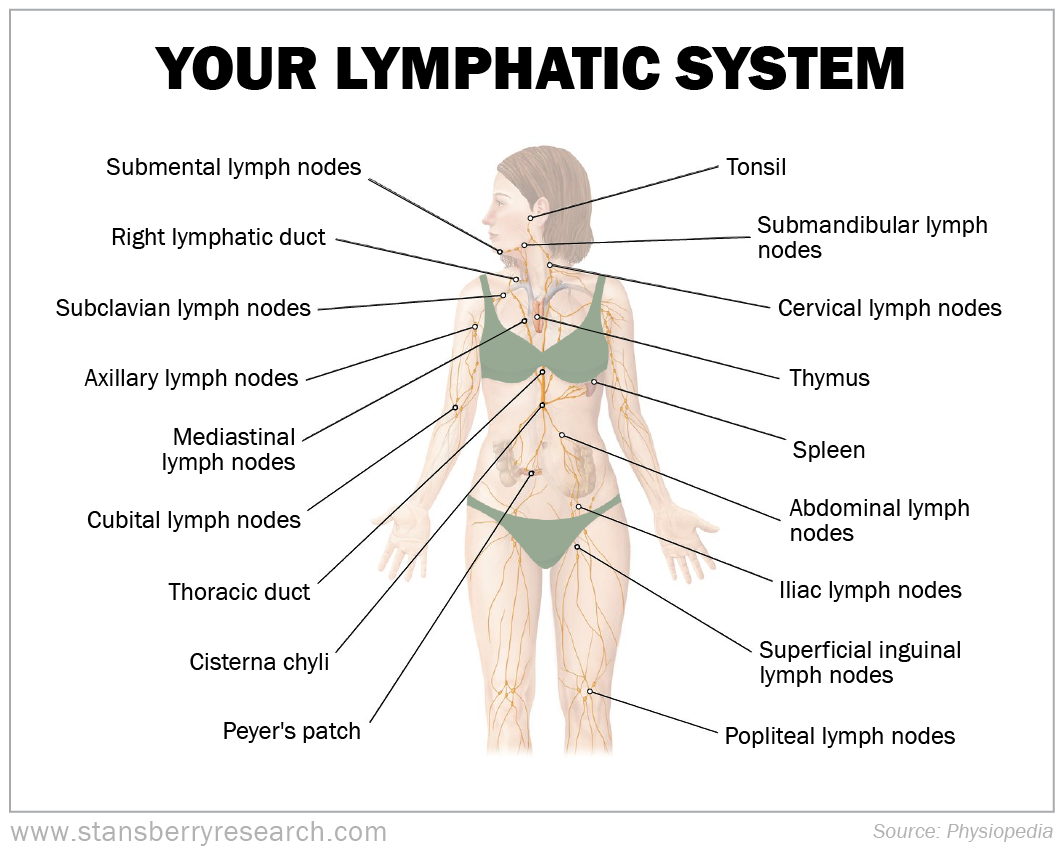In 1930s Paris, a radical new way to treat runny noses emerged...
Two Danish doctors, Emil and Estrid Vodder – a husband and wife team – used what they called manual lymphatic drainage ("MLD") to treat colds.
At the time, the lymphatic system wasn't well studied. But the Vodders often treated patients complaining of runny noses and colds, and many of these patients also had swollen lymph nodes. They theorized that there was a connection between the lymphatic system and the immune system. So they mapped out the system and created the MLD treatment to promote lymph movement and drainage to help their patients heal from various ailments.
Today, we know that the lymphatic system is an elaborate network in your body that moves excess blood plasma and immune cells (in lymphatic fluid) throughout the body. This fluid is a critical part of eliminating waste from your system. Lymph nodes store the immune cells your body needs to fight disease.
Take a look...

Swollen lymph nodes are a signal that your body isn't properly draining and detoxifying your lymph fluid. These swollen nodes can be due to infection (like a cold), cancer, or an immune system disorder. Even some medications can cause swollen lymph nodes.
Studies show MLD is good for injury healing... including a meta-analysis of three studies on manual lymphatic drainage techniques ("MLDTs") being used in sports medicine. Penn State University researchers found that MLDTs were effective for reducing swelling due to wrist or ankle sprains, and to remedy damaged cells in muscle tissue.
According to a 2022 randomized controlled trial study on 39 folks in Taiwan, lymphatic drainage improves pain and range of motion in the neck and shoulders – caused by lymphedema – after surgery for oral cavity cancer...
One group – the control – received 30 minutes of physical therapy ("PT"). The experimental group received 30 minutes of PT exercise and as well as 30 minutes of MLD. The study showed that early MLD intervention improved participant range of motion in the neck.
A 2023 review also found MLD promotes healing and reduces swelling in patients who underwent cosmetic procedures, like liposuction and face lifts.
How MLD Works
MLDTs stimulate the lymph nodes by replicating the way they naturally contract. So by making gentle, rhythmic stretches to the skin, you can jump-start your lymph system and help clear any blockages.
MLD has four distinct techniques:
1. Pump technique – With the palm facing down, the therapist makes long, oval-like movements with their fingers and thumb, slowly walking the hand up the limb with each stroke.
2. Rotary technique – Using the palms of the hands, the therapist will massage the skin in circular motions, applying pressure – as needed – with the wrists.
3. Scoop strokes technique – The therapist places their palm facing up and cups the fingers to resemble a "U" shape. The stroke motion is a gentle and repetitive twisting and stretching of the skin and muscle tissue.
4. Stationary circles technique – The therapist uses their fingertips to make five circular motions in one place. This move is typically used on the face, neck, and lymph nodes.
(Here's a collection of videos showing the four MLDTs in action.)
You can try your own lymphatic exercises at home to stimulate excellent lymphatic flow...
1. Dry brushing – Lightly brushing your skin with a soft bristle hairbrush, or even just your fingers, activates your lymphatic system. The gentle stimulation on your skin gets lymphatic fluid moving toward your lymph nodes, where it is cleaned and filtered.
2. Deep breathing – Taking slow, deep breaths encourages your lymph to circulate around your body, removing waste products along the way. Expanding and contracting your belly while you breathe also effectively encourages lymph movement.
3. Walking – Just 20 minutes of walking is enough to get your body circulating out toxins and waste from your lymphatic system.
4. Swimming – Moving through water compresses your lymph nodes and gets the system pumping.
5. Tapping – Lightly tapping the skin above your collarbones activates tiny lymphatic vessels lying right beneath the surface.
Manually massaging and moving in ways that promote lymphatic flow is an important component of your general health. Your lymphatic system impacts many aspects of your wellbeing, like your immune response and your range of motion. So make sure yours is working well.
And send us an e-mail at [email protected] if you've had personal experience with MLD. We'd love to hear about it.
What We're Reading...
- How to perform a lymphatic drainage massage.
- Try out this dry brushing technique (video).
- Something different: Feeling lost? Here's how to find your way.
Here's to our health, wealth, and a great retirement,
Dr. David Eifrig and the Health & Wealth Bulletin Research Team
March 12, 2024
